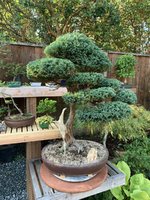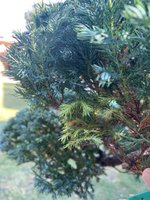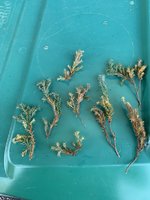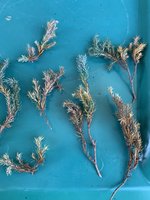dacoontz
Mame
Fellow nutters, I have asked you about this tree before and I have questions yet again. Honestly this is a tree that I probably don’t deserve to own but I do my best to keep it in good shape. This year I had intended to repot it but our temperatures in the spring got too hot way too fast and I felt that I missed my window. Roots are fairly dense all the way to the edges of the pot and I know it’s been at least three years since this tree was repotted.
Other than that the only thing I’ve been doing with it is trying to give it good air circulation, partial sun, not much fertilizer, and staying on top of its constant growing foliage. I’ve had to do some fairly extensive pinching 2 to 3 times this growing season.
Full disclosure, I did do some wiring this year and found that the tree swelled up quite a bit over the last several weeks causing some pretty good scarring in the crown of the tree.
My concern is that it has areas where it seems to be yellowing from the inside out. It did this once last year also but did seem to bounce back. The last time seemed more localized though. This time it seems to be more widespread. I’m wondering if it has to do with the density of the foliage and not allowing light in. But I’m also concerned about pests and the fact that I missed the repotting opportunity. Part of me wonders if I should try to repot it now but I certainly don’t want to stress the tree out unnecessarily if it could wait till spring. Here’s some pictures of the tree and the foliage that I ended up having to remove. I feel like I had to remove quite a bit of what appeared to be dying foliage. And I apologize if I’m asking a similar question that I have before. There just is not a lot of information about Boulevard Cypress for Bonsai to provide me reassurance.





Thank you for the thoughts that you might have.
Other than that the only thing I’ve been doing with it is trying to give it good air circulation, partial sun, not much fertilizer, and staying on top of its constant growing foliage. I’ve had to do some fairly extensive pinching 2 to 3 times this growing season.
Full disclosure, I did do some wiring this year and found that the tree swelled up quite a bit over the last several weeks causing some pretty good scarring in the crown of the tree.
My concern is that it has areas where it seems to be yellowing from the inside out. It did this once last year also but did seem to bounce back. The last time seemed more localized though. This time it seems to be more widespread. I’m wondering if it has to do with the density of the foliage and not allowing light in. But I’m also concerned about pests and the fact that I missed the repotting opportunity. Part of me wonders if I should try to repot it now but I certainly don’t want to stress the tree out unnecessarily if it could wait till spring. Here’s some pictures of the tree and the foliage that I ended up having to remove. I feel like I had to remove quite a bit of what appeared to be dying foliage. And I apologize if I’m asking a similar question that I have before. There just is not a lot of information about Boulevard Cypress for Bonsai to provide me reassurance.





Thank you for the thoughts that you might have.



